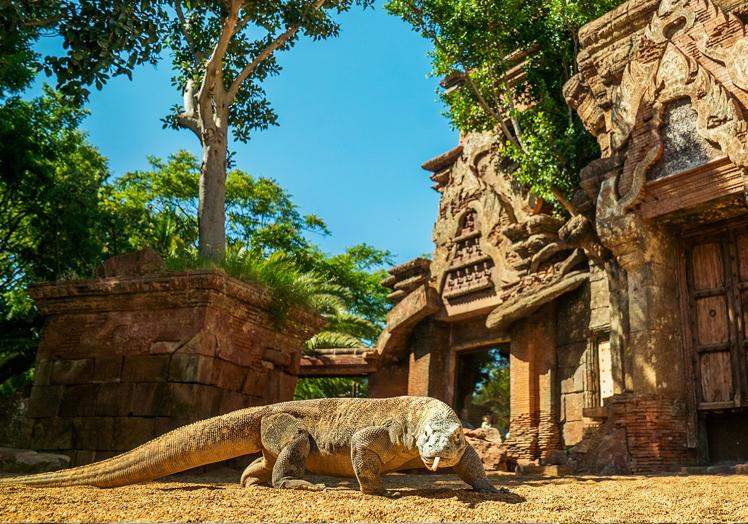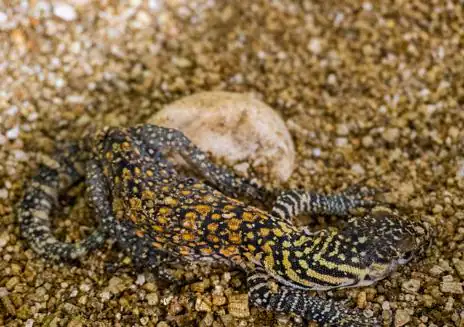

Secciones
Servicios
Destacamos

Raquel Merino
Malaga
Tuesday, 28 March 2023, 17:07
The birth of five young Komodo dragons marks Bioparc Fuengirola as the first park in Spain to achieve this rare feat in the last 10 years and only the fifth in Europe.
The Komodo dragon is a large reptile that is in serious danger of extinction. They can grow to a maximum length of 3 m (9.8 ft), and weigh up to 70 kg (150 lb) in the wild, or more in captivity. Only about 1,500 specimens remain worldwide, some 220 in conservation centres belonging to the European Association of Zoos and Aquariums (EAZA) and the rest roam in freedom on the Indonesian islands of Flores, Komodo, Rinca, Padar, Nusa Kode and Gili Motang.
Young Komodo dragons are vulnerable and dwell in trees to avoid predators, including cannibalistic adults. They take 8 to 9 years to mature and generally live up to 30 years.
In the last 15 years the population of Komodo dragons has been reduced by 25% due to the burning of a large part of the forest where they live and due to poaching. Added to this the enormous accumulation of waste that ocean currents carry and which ends up on the islands where these primitive and great monitor lizards live in the wild.
Since 2009, Bioparc Fuengirola and the Bioparc Foundation have been working on the Komodo Dragon Endangered Species Programme (EEP) both at its facilities, and 'in-situ' on the island of Flores under the Komodo Survival project banner.
Ora and Reo are the proud parents of the five hatchlings on the Costa del Sol. After a laborious copulation monitored by veterinarians and members of the Bioparc Fuengirola Herpetology team, it was detected that "Ora was more restless than usual," said the park. The result was her laying a dozen eggs.
Then came eight months of controlled and daily-monitored incubation of the eggs. "Every week, both the temperature and the humidity of the incubation facilities were regulated, guaranteeing a perfect environment for the development of the embryos and simulating the possible seasonal variations to which they could be exposed in their natural habitat," Bioparc sources explained.



Finally, at the beginning of March, this process ended with the hatching of the first of the young called Juanito. He was followed by Phoenix, Embum, Drakaris and Saya. "Although the initial clutch was 12 eggs, only five of them were finally viable." The larger ones hatched on their own, while the smaller ones needed help because they were still attached to the yolk. The hatchlings have weights ranging from 50 to 120 grams, and measure from 30 to 44 centimetres.
“The success of the laying, incubation and hatching not only represents a hopeful future for this endangered species, but also demonstrates how necessary the work we do at our centre is. From the first moment, we have guaranteed the well-being of both reptiles and now also their young. For everyone, it is undoubtedly a great achievement”, said Milagros Robledo, head of Herpetology at Bioparc Fuengirola.
Now, just like in the natural habitat of this species, from the moment they are born, the young live separately from their parents and completely independently. Hence, they remain in separate terrariums at the park on the Costa del Sol.
Just a year ago, Reo, the father of the hatchlings became the first of his species to undergo cataract surgery in Europe.
Bioparc Fuengirola is one of the 30 zoos that are part of the European Endangered Species Programme for this species, coordinated by the European Association of Zoos and Aquariums.
Publicidad
Publicidad
Publicidad
Publicidad
Esta funcionalidad es exclusiva para registrados.
Reporta un error en esta noticia

Debido a un error no hemos podido dar de alta tu suscripción.
Por favor, ponte en contacto con Atención al Cliente.

¡Bienvenido a SURINENGLISH!

Tu suscripción con Google se ha realizado correctamente, pero ya tenías otra suscripción activa en SURINENGLISH.
Déjanos tus datos y nos pondremos en contacto contigo para analizar tu caso

¡Tu suscripción con Google se ha realizado correctamente!
La compra se ha asociado al siguiente email
Comentar es una ventaja exclusiva para registrados
¿Ya eres registrado?
Inicia sesiónNecesitas ser suscriptor para poder votar.